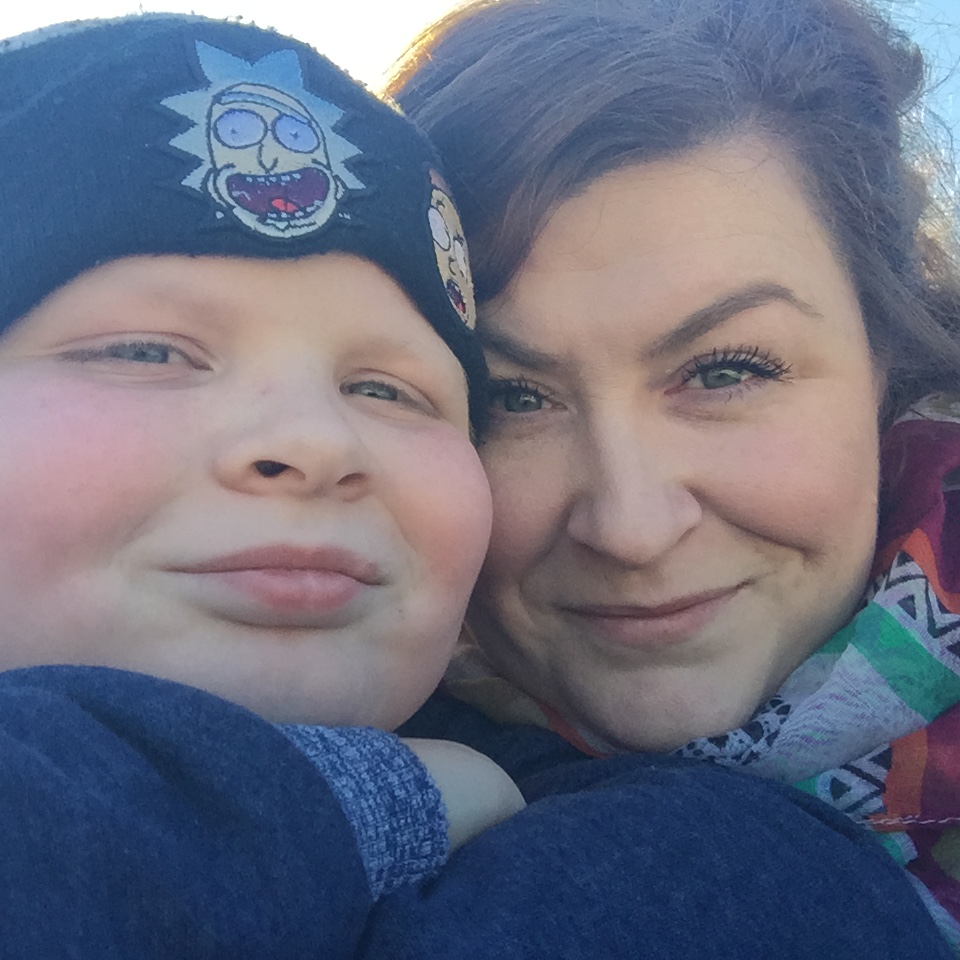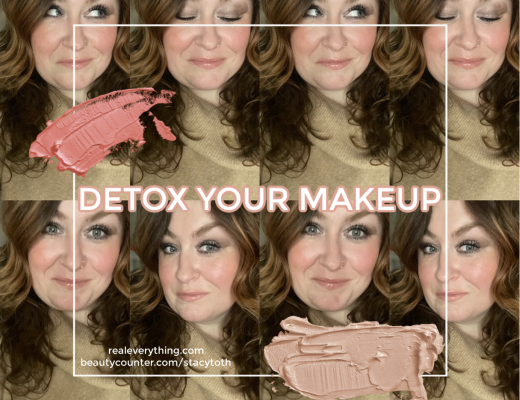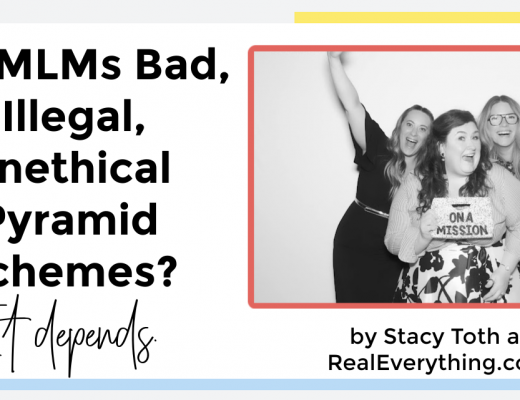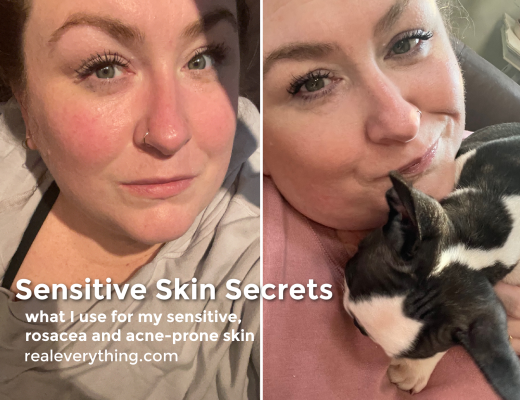Safer skincare for teens is a most frequently asked question! I know this is going to get long winded, so here’s what you’ll find in this post:
- Why Safer Skincare & Cleaner Cosmetics for teens matters
- Get them on board: empower with information and educate
- How to help them get healthy inside & out
- Safer alternative suggestions
- If you want more info, Join my Healthy Inside & Out Facebook Group and Safer Skincare E-mail List
Before we get started, don’t forget to join my Safer Skincare list for more info like this as well as sales specials on many of the products noted here today! ♥
With hormone changes it’s often the first time kids start thinking of skincare beyond sunblock in the summer. These days, it’s an even more important topic because incredibly dangerous and toxic stuff being sold to our babies. Understandably, we don’t want to give asbestos and heavy metals or hormone altering chemicals to already hormone-crazed (pre)teens we’ve nurtured their whole lives; if you’re like me, you spend way too much money on real foods and breastfed and cloth diapered to keep your kids as safe and healthy as possible. Just when you think you’re in the clear, this toxic ish bubbles up.
Problem is, once they hit those double-digit years, they want nothing to do with you, your ideas and recommendations anymore. What can we do?
- Educate
- Explain how being healthy inside their bodies affects their appearance
- Provide them with safer alternatives
I promise, this isn’t rocket science. It seems overwhelming at first, but really their needs are just the same as our own. They may want eyebrow pencils instead of anti-aging cream, but we can all understand where the other is coming from if we communicate. Here are my tips for success.
Education
I found that the best way to get my kids to listen to what I say is to treat them as equals. I share information and help educate them on topics so they can make informed decisions. When Cole started going through puberty (shh, don’t tell him I said the P word) and I saw his first zit, we talked about it. Car rides with the two of us is the best way, since there’s no eye contact and no escape.
I explained that what he learned in Family Life Education (insert a joke to alleviate the tension from the P word) about puberty is legit. And it’s happening. We talk about taking a shower more often because hormone changes cause body changes, like oil secretion and sweat glands. We talk about how the lifestyle choices we make affect us. I discussed a high-level how-to on the skincare products I recommended, what order to use them in, and how they can help treat acne. Then we sit in awkward silence until we get home and he asks for “the stuff.”
Here are some good articles to start with:
- Tests find toxic chemicals in children’s Halloween makeup, USA Today
- What was Asbestos Doing In Children’s Makeup, Forbes
- The Hidden Dangers of Makeup and Shampoo, Times
- Teen Girls’ Body Burden of Hormone-Alterning Cosmetics Chemicals, EWG
- and most importantly, EWG’s study that shows just 3 days use of safer ingredient products reduces toxic chemicals levels in their bodies
After three days, the teens’ urine tests showed these decreases in the concentrations of the cosmetics ingredients under study:
- 44 percent down in levels of methyl and propyl paraben. Parabens are preservatives widely used in cosmetics, shampoos and skin lotions.
- 35 percent down in triclosan, an antibacterial chemical common in liquid antibacterial hand soap, dishwashing detergent, toothpaste, face wash and deodorant. Triclosan has been linked to the disruption of thyroid and reproductive hormones.
- 27 percent down in mono-ethyl phthalates. Phthalates, common industrial plasticizers, show up in some nail polish and fragrances. [source]
Claims vs. Facts
I make it very clear that my family learned all of this and made the choice to switch to Beautycounter for about 90% of our personal care products. We don’t promote them because we’re brand ambassadors, we’re brand ambassadors because we sincerely use and love them. Specifically, Beautycounter is the ONLY brand that I know of that is TESTING both ingredients and finished products for safety – of both hormone disrupting chemicals as well as heavy metals.
Did you know any brand can make any claim they like about any personal care product without needing to test or prove it? Natural, organic, BPA-free, you name it – no standards. The thing about personal care and cosmetics is that there are so many possible contaminants. Something as simple as a rose being picked and put into a plastic bag by the farmer instead of canvas will leave measurable levels of BPA in an otherwise plastic and BPA-free product. No one would know the product contained BPA unless testing occurred. The FDA doesn’t require testing or have these standards; this is why it’s essential to use brands that are committed to testing for safety. No one knows unless you TEST.
How to tell what’s safe
Color cosmetics contain asbestos and heavy metals (like lead), and that’s just the stuff they put in on accident – let alone the known toxic chemicals added on purpose. Without testing even natural, organic, or high-end brands cannot claim a product is safe. This is not just about paying more and avoiding cheap stuff. Things I look for are:
- Are all ingredients disclosed and prominently displayed?
- Does the brand work with industry to improve health safety overall (such as the Counteract Coalition)?
- What is the product’s safety rating on EWG’s Skin Deep database?
- If claims are made, what is backing it up – don’t tell me, show me?
- And, are the products evaluated by a 3rd party?
I love the EWG app because you can snap a pic of a barcode and it’ll do the work for you.
Here’s an example of 2 Beautycounter products versus two comparative ones you’d commonly use on teens. I even choose versions marketed or thought to be “safe.”
Top Ingredients to look for and avoid
If you read labels and ingredients then at least you have a place to start with knowing what to avoid. While our family has come to trust Beautycounter after nearly two years of use and their commitment to better standards and regulation, it’s certainly not the only brand we use! Things like toothpaste and deodorant can be harmful to health as well. Here’s a list of ingredients and why we avoid them:
Parabens. These are preservatives that prevent the growth of bacteria, mold and yeast in cosmetic products. Parabens possess estrogen-mimicking properties that are associated with increased risk of breast cancer; they are absorbed and have been identified in biopsy samples from breast tumors. They can be found in makeup, body washes, deodorants, shampoos and facial cleansers. You can also find them in food and pharmaceutical products.
Fragrance. What does “fragrance” mean anyway? This term was created to protect a company’s “secret formula.” You could be putting tons of chemicals that are hazardous to your health on and have no idea. Fragrance mixes have been associated with allergies, dermatitis, respiratory distress and potential effects on the reproductive system. It can be found in many products such as perfume, cologne, conditioner, shampoo, body wash and moisturizers.
Phthalates. A group of chemicals increases flexibility and softness of plastics; main phthalates in cosmetics and personal care products are dibutyl phthalate in nail polish, diethyl phthalate in perfumes and lotions, and dimethyl phthalate in hair spray (they’re also often found in deodorants, perfumes/colognes, hair sprays and moisturizers). They are known to be endocrine disruptors and have been linked to increased risk of breast cancer, early breast development in girls, and reproductive birth defects in males and females. Unfortunately, it often hidden as a “fragrance.”
Triclosan. An antimicrobial chemical that’s a known endocrine disruptor — especially thyroid and reproductive hormones, and a skin irritant. Studies raise concerns that triclosan contributes to making bacteria antibiotic-resistant. There also wasn’t significant evidence that antibacterial soaps containing triclosan provides any benefit over regular soap and water. Tricolson are found in toothpastes, antibacterial soaps and deodorants.
Sodium lauryl sulfate (SLS) / Sodium laureth sulfate (SLES). This surfactant is in more than 90% of personal care and cleaning products (think foaming products like shampoo, body wash/cleanser, mascara and acne treatment). SLS’s are known to irritate skin, lung, and eye and can cause kidney and respiratory damage. SLS can interact and combine with other chemicals to form nitrosamines, a carcinogen.
Formaldehyde and Formaldehyde-releasing preservatives (FRP’s) are in many cosmetic products to help prevent bacteria growth. Deemed a human carcinogen by The International Agency for Research on Carcinogens (IARC) it has been linked to occupational related cancers: nasal and nasopharyngeal. It causes allergic skin reactions and may also be harmful to the immune system. Found in almost all personal care products.
Toluene. A petrochemical derived from petroleum or coal tar sources. Listed as benzene, toluol, phenylmethane, methylbenzene; it is a potent solvent able to dissolve paint. It affects your respiratory system, cause nausea and irritate your skin as well as cause developmental damage in the fetus. Toluene has also been linked to immune system toxicity. It is found in nail polish, nail treatments and hair color/bleaching products.
Sunscreen chemicals. These chemicals function as a sunscreen agent, to absorb ultraviolet light. These chemicals are endocrine disruptors and are believed to be easily absorbed into the body. They may also can cause cellular damage and cancer in the body. Common names are benzophenone, PABA, avobenzone, homosalate and ethoxycinnmate. More recently, they are often found to be contaminated with Benzene, a known carcinogen. [abridged from this source, read full article for more]
Lifestyle Choices: gut health
As children get older, I think it’s important to remember that they are their own people. Their body is theirs to make their own choices. One of my boys, I won’t name names *cough*Cole*cough* does not stay gluten-free when he goes out with friends. He comes home bloated, grumpy, and spends more time in the bathroom than usual. But it’s his choice. I talk to him and he understands his choice, so it’s his to make.
 My teen. I so rarely get a decent photo with Cole these days,
My teen. I so rarely get a decent photo with Cole these days,
he’s usually looking for a laugh with a snarl or snark…
My younger son, however, has a hard time realizing what makes his eczema flare. He genuinely tries to make choices that won’t inflame his skin; but, sometimes forgets or doesn’t realize where nightshades and dairy hide. All of this is to say, as our kids get older we have to empower them to make their own choices. Which is why education is so important. Here’s the list of things I prioritize with the boys to support their gut health:
- Gluten (and grains), dairy, and sugar have the most impact on your skin; avoid if inflamed. We outline a family-friendly way to do this and describe it as Phase 1 in our book Real Life Paleo and ebook 3 Phase Paleo.
- Probiotics I recommend and use multiple forms of probiotic, we get a lot in yogurt and kombucha but we also take a soil based probiotic – this is the one I use and recommend and was used by the client in the before and after photo.
- Sleep because your cells need to regenerate to heal and the only time they can do that is when you are sleeping! DON’T FORGET TO USE CLEAN LAUNDRY DETERGENT (we use this one) and to change pillow cases often. If someone has a lot of inflammation (acne) on their face, I’d change it no more than once a week.
- Hydration – drink plenty of fluids, especially water! If you don’t like plain water then make a big pitcher with herbs, cucumber, citrus or other fruit that you do like; tea is also a good alternative, lots of herbal teas (my boys love the strawberry, blueberry and pineapple from Teavanna) are delicious!
While I’m all for educating and empowering our kids, when it’s in my home or with my money then my rules apply. We drink water at our meals. They follow a bed time that we prescribe. If you ask them we’re militant, if you ask other people we’re not strict enough. What matters is your kids’ well being.
 My preteen. The funk runs strong with him!
My preteen. The funk runs strong with him!
Options for safer skincare for teens
It’s important to choose the right product for you. Here’s the surprise: So often I see kiddos whose face is so dry (tight, red, flaking skin) who are inflamed and using products to “dry out” the acne. But what is really happening is that those drying products break the lipid barrier of the skin, allowing it to be more susceptible to bacteria, which is often the true culprit of the acne. Not everyone is the same and different products will work differently for different people.
What I’ve done here is outline 3 overall recommendations for what I’m calling Teen Kits. Ranging from the basic starting point to both skincare and cosmetics, each comes with it’s own printable instruction guide on how to use the products. Remember, all of these products likely have unsafe ingredients unless you’re checking and buying conscientiously:
- Deodorant
- Hair products
- Skincare (moisturizers and acne)
- Lotions
- Body wash
- Perfume, cologne, and body spray
- Make-up
- Sunscreen (use this one)
Teen Kit 1 – Defunk the Tweens
- Shower & soap: at least every other day using either body wash or bar soap. Make sure to scrub face (behind the ears), armpits, feet and groin – but be sure to not put soap inside your body. Use either the Body Wash, Charcoal Body Wash, or Charcoal Cleansing Bar. The charcoal bar in particular is wonderful at pulling out oil and impurities, especially for those who are acne-prone; the body washes suds up nice and lather without SLS.
- Shampoo & hair care: avoiding foaming agents in shampoo is hard, Beautycoutner’s Daily Shampoo & Conditioner is what all my kids (and husband) use and love – and they all have different hair types and lengths. They foam without unsafe ingredients and they also are color safe if your 10 year old has blue hair.
- Deodorant, I go into detail on our beloved Clean Deo in this post here. If you have sensitive skin, use the Charcoal Balancing Mask and Charcoal Cleansing Bar as described.
Teen Kit 2 – Skincare for Teens
- Teens have fluctuating hormones that affect their skin. Focusing on nourishing from the inside out with plenty of water, probiotics, changing the sheets and pillow cases often (many find silk and organic cotton help) with a clean detergent (we use this one). Then, a skincare routine that includes wash, prep, treat, and protect is needed – tho we know a teen will likely rarely do all the steps consistently. The simplest routine:
- Wash: Either the Charcoal Cleansing Bar or Clear Pore Cleanser if the skin is very oily. If skin is “combination”, that is patches of dry and oily skin, then I suggest the Cleansing Balm which will help to heal the skin’s protective moisture barrier, the building blocks of which are lipids.
- Prep with a simple spray toner, I like anti-inflammatory rosewater mists, look for one without “fragrance” in the ingredients, like Herbivore’s Hibiscus Rose Mist.
- For treatment, to repair that lipid barrier we need to add oils to help the skin repair the building blocks of the moisture barrier, which protects bacteria from entering. Balancing Facial Oil works well, I recommend just adding a few drops to the protect step to simplify for teens.
- Protect: my absolute top 2 recommendations for teen moisturizer include mineral SPF, which both protects skin from UV damage and blue light from all that screen use, but the natural zinc-oxide has anti-inflammatory properties which reduce acne. Choose either the Countersun Sheer Defense or the sheer tinted Dew Skin Moisturizer. Dew Skin has additional benefits from fruit acid (Vitamin C) to brighten to even skin tone and reduce the appearance of pores.
- Additional acne treatments, use the Charcoal Balancing Mask weekly or spot treat as needed. Leave it on the spot overnight or used as a mask until it dries (5-10 minutes). Apply to clean skin (to make sure dirt isn’t put into the pores when they open) and then tone and moisturize after when skin is primed to take in nourishment. This mask has amazing results: 94% said mask absorbed excess oil; 87% said mask detoxified pores and purified skin; 87% said mask helped clarify complexion; 84% said mask made skin look clearer and more even-toned. The Countercontrol SOS Acne Spot Treatment is also excellent if you can catch a blemish as it is surfacing.
Teen Kit 3 – Cleaner Cosmetics
I outline my favorite products for teens and how to use them below. Alternatively, the Flawless in 5 (5 minute face set) is a great all-in-one solution to replacing cosmetics and is discounted when bought together, all products included (Dew or Twin Skin, Creamy Concealer, Blush/Bronzer, Eyebrow Gel or Pencil, Think Big Mascara, and Gloss) are customizable to the color selections you’d like.
- Follow the Defunk and Skincare routine outlined above.
- Flawless in Five, includes Dew Skin or Skin Twin. Dew Skin is my preference for teens because it contains natural zinc-based SPF that also helps reduce dry skin, inflammation, and acne. Dew Skin is a tinted moisturizer, so it’ll give extra moisture while also giving a dewy-glow (this product won Allure Magazine’s Best Of). Instead of Skin Twin for more coverage, FiF includes beloved Creamy Concealer, as well as brow gel or pencil, blush, mascara and gloss – a perfect simple makeup look (it’s what I use)!
- Apply Eye Make-up: Pencils. Gone are the days of thin eyebrows! Brows are the new black, friends. And frankly, I’d much rather a teen put a sharp object on their brow instead of the edge of their eye, but either way carefully apply either or both to your desired affect. Beautycounter has both Color Outline Eye Pencil (eyeliner) as well as Color Define Brow Pencil (eyebrow) as well as my favorite the Brilliant Brow Gel. The pencils each have a tool at the other end to help with application and use.
- Apply Eye Make-up: Mascara. As a teen I would forego all else but HAD to wear mascara. If your teen is wanting mascara there isn’t a safer one than Beautycounter’s EWG-verified tested for safety (no heavy metals or contaminants like PFAS) Think Big All-in-One Mascara.
- Finish with Gloss. From a dark and lovely Mulberry to the bare nude, Bare Shimmer, Beautycounter’s Lip Glosses are one of my favorite products. They deliver a subtle shine without stickiness and wear off evenly. They make them with nourishing ingredients that will moisturize the lips and do not contain any nasty chemicals you wouldn’t want to consume when wearing, since women eat up to one pound of what they put on their lips per year! Ooh, teens also love The Jellies!
- Remover – teens love the One-Step Make-up Removing and Cleansing Wipes! This micellar based wipe cleanses while it removes make-up in one step. It’s also compostable and eco-friendly while being safe!
I hope this was helpful. If you have questions, ask away! Team Healthy Inside & Out also offers skin consultations (no purchase necessary). I probably know someone local to you that can let you touch and try these products personally – comment or e-mail me so I can help!
learn more about healing the skin barrier in this article
Never want to miss a post, sale, or deal? Join my Healthy Inside & Out e-mail list for more info on non-toxic living and safer skincare!
Want more info on our Real Life? Healthy recipes, parenting tips, and general lifestyle stuff goes out in our Real Everything newsletter, join here.








